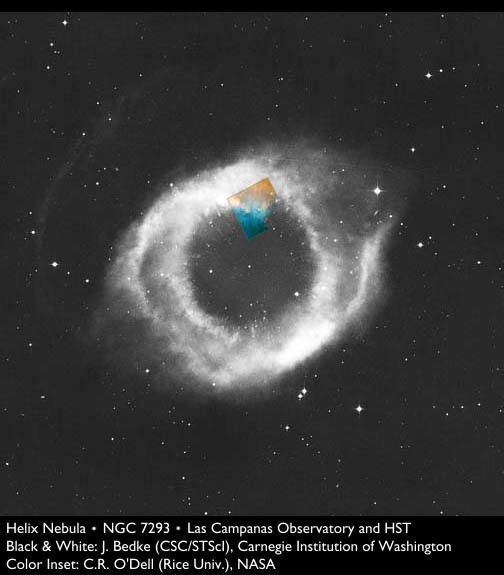1 min read
Location of HST Image of Helix Nebula in a Larger Ground-Based View

About the Object
- R.A. PositionR.A. PositionRight ascension – analogous to longitude – is one component of an object's position.22h 29m 30.0s
- Dec. PositionDec. PositionDeclination – analogous to latitude – is one component of an object's position.-19° 9' 50.0"
- ConstellationConstellationOne of 88 recognized regions of the celestial sphere in which the object appears.Aquarius
- DistanceDistanceThe physical distance from Earth to the astronomical object. Distances within our solar system are usually measured in Astronomical Units (AU). Distances between stars are usually measured in light-years. Interstellar distances can also be measured in parsecs.450 Light Years
- Object NameObject NameA name or catalog number that astronomers use to identify an astronomical object.Helix Nebula, NGC 7293
- Object DescriptionObject DescriptionThe type of astronomical object.Planetary Nebula
- Release DateApril 15, 1996
- Science ReleaseHubble Finds Thousands of Gaseous Fragments Surrounding a Dying Star
- Credit
Related Images & Videos

Collision of Gases Near a Dying Star in the Helix Nebula
This colorful image from the Hubble Space Telescope shows the collision of two gases near a dying star. Astronomers have dubbed the tadpole-like objects in the upper right-hand corner "cometary knots" because their glowing heads and gossamer tails resemble comets. Although...

Comet-Like Knots Around a Dying Star in the Helix Nebula
These gigantic, tadpole-shaped objects are probably the result of a dying star's last gasps. Dubbed "cometary knots" because their glowing heads and gossamer tails resemble comets, the gaseous objects probably were formed during a star's final stages of life. Hubble astronomer...
Share
Details
Last Updated
Aug 17, 2025
Contact
Media
Claire Andreoli
NASA’s Goddard Space Flight Center
Greenbelt, Maryland
claire.andreoli@nasa.gov




























